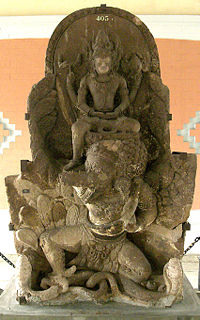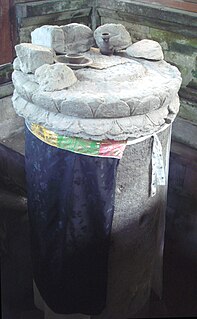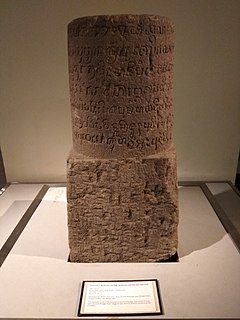Related Research Articles

The Shailendra dynasty was the name of a notable Indianised dynasty that emerged in 8th-century Java, whose reign signified a cultural renaissance in the region. The Shailendras were active promoters of Mahayana Buddhism with the glimpses of Hinduism, and covered the Kedu Plain of Central Java with Buddhist monuments, one of which is the colossal stupa of Borobudur, now a UNESCO World Heritage Site.

The Mataram Kingdom was a Javanese Hindu–Buddhist kingdom that flourished between the 8th and 11th centuries. It was based in Central Java, and later in East Java. Established by King Sanjaya, the kingdom was ruled by the Shailendra dynasty and Ishana dynasty.

Airlangga, regnal name Rakai Halu Sri Lokeswara Dharmawangsa Airlangga Anantawikramottunggadewa, was the only raja of the Kingdom of Kahuripan. The Kingdom was built from the territory of the Kingdom of Medang after Medang was sacked by king Wurawari of Lwaram. He gradually gained support, won back the kingdom once ruled by his uncle, and went on to become one of Java's most notable kings. Airlangga literally means "jumping water", thus his name means "he who crossed the water", described his life story; born in the court of Bali and during his youth crossed the Bali Strait to stay in Java and later ruled the kingdom in East Java. He belongs to both Isyana and Warmadewa lineages.

Sanjaya complete name in inscription as Narapati Raja Śrī Sañjaya (Canggal) and Rakai Matarām Saŋ Ratu Sañjaya (Mantyasih), was the founder of Mataram Kingdom during the eighth century. His name was revealed in the Sanskrit Canggal inscription carved in a stone found at Gunung Wukir temple that stood on Wukir or Ukir hill on the southern Kedu Plain in Central Java.

The Sunda Kingdom was a Sundanese Hindu kingdom located in the western portion of the island of Java from 669 to around 1579, covering the area of present-day Banten, Jakarta, West Java, and the western part of Central Java. The capital of the Sunda Kingdom moved several times during its history, shifting between the Galuh (Kawali) area in the east and Pakuan Pajajaran in the west.
Sri Baduga Maharaja or Sang Ratu Jayadewata was the great king of the Hindu Sunda kingdom in West Java, reigned 1482 to 1521 from his capital in Pakuan Pajajaran. He brought his kingdom greatness and prosperity.

Sri Kesari Warmadewa was the first king of Bali whose name is recorded in a written inscription. He was the issuing authority for four inscriptions, including the famous 914 CE inscription on the Belanjong pillar in southern Sanur.

The Warmadewa dynasty, also Varmadeva dynasty, was a regnal dynasty in the island of Bali.
The Mantyasih inscription is an important inscription found and kept by Li Djok Ban in Ngadireja Parakan Temanggung, then the inscription was brought by one of the princes of Surakarta to be brought to Surakarta and is now stored in the Radyapustaka Museum, Central Java, Indonesia. It is dated to 907 and was created by King Balitung from the Sanjaya dynasty, of the Ancient Medang Kingdom. This inscription contains a genealogy of the kings of Medang before King Balitung.

Dapunta Hyang Sri Jayanasa was the first Maharaja (Emperor) of Srivijaya and thought to be the dynastic founder of Kadatuan Srivijaya. His name was mentioned in the series of Srivijayan inscriptions dated from late 7th century CE dubbed as the "Siddhayatra inscriptions", describing his sacred journey to acquire blessings and also to conquer neighboring areas. He reigned around the turn of late 7th century to early 8th century, more precisely in the period between 671 and 702 CE.

The Kingdomship of Bali was a series of Hindu-Buddhist kingdoms that once ruled some parts of the volcanic island of Bali, in Lesser Sunda Islands, Indonesia. With a history of native Balinese kingship spanning from the early 10th to early 20th centuries, Balinese kingdoms demonstrated sophisticated Balinese court culture where native elements of spirit and ancestral reverence combined with Hindu influences – adopted from India through ancient Java intermediary – flourished, enriched and shaped the Balinese culture.
Śri Wijaya Mahadewi of Bali, was a queen regnant of the Kingdom of Bali in 983-989.
Sri Makutawangsa Wardhana was the king of Medang Kingdom, in East Java, that ruled prior to 990s CE. He was the son and the successor of Queen Isyana Tunggawijaya and King Sri Lokapala. He belongs to the Isyana dynasty, established by his grandfather, Mpu Sindok that ruled Java circa the 10th century CE.
Śri Ajñadewi was a reigning queen of Bali, who flourished in 1016 CE.
Sang Ratu Aji Tabanendra Warmadewa was a king from the Warmadewa dynasty, who is thought to have ruled in Bali between 877-889 Saka. His name is mentioned on three inscriptions in Manik Liu village, dated the 1st of Srawana month in the year of 877 Saka; and in another inscription in Kintamani village, dated the 6th of Bhadrapada month, Suklapaksa in the year of 889 Saka.

Munggu Antan inscription is an inscription in the form of a stone stele found in the village of Bulus, Purworejo Regency, which was once included in the Kedu Residency. This inscription contains the designation of the village Munggu Antan as a sima dedicated to a temple in Gusali, and it is written in Sanskrit. This inscription was issued by Sang Pamegat Munggu and his younger sister Sang Hadyan Palutungan, who was also the wife of Sang Dewata at Pastika, at the behest of Sri Maharaja Rake Gurunwangi, dated 808 Saka or 887 CE.
The Balinese copperplate inscription or Sembiran inscription is actually a collection of ten copper plate inscriptions, which were found in the village of Sembiran, Tejakula district, Buleleng Regency, on the northern part of Bali island. All inscription plates have a date, which is between 922 and 1181 CE, so they include a period of more than 200 years. Sembiran AI is dated 844 Saka, Sembiran B is dated 873 Saka, Sembiran A II is dated 897 Saka, Sembiran A III is dated 938 Saka, Sembiran A IV is dated 987 Saka, and Sembiran C is dated 1103 Saka. Some of the oldest inscriptions are written in Old Balinese, while some of the later ones are written in Old Javanese.
Sang Ratu Sri Ugrasena was a Balinese king who is thought to have ruled between 837-864 Saka, or 915-942 CE. The capital of his kingdom was in Singhamandawa. The king issued several inscriptions regarding various activities of his people, including the giving of royal endowment, tax regulation, religious ceremony, and construction of public lodge and place of worship for pilgrims. His reign was approximately the same period as King Sindok's of the Isyana dynasty in East Java.

The history of Sunda Kingdom spanned almost a millennium, between 7th to 16th century. It is not sure however, whether the Sunda Kingdom was actually a continuous polity or not, nor whether its rulers belongs to a single continuous lineage of dynasty or not. This is because the scarcity of evidences, historical records and archaeological findings that plausibly connected to this kingdom.
Çri Maharaja Çri Ragajaya was a Balinese king who ruled in the middle of the 12th century CE. The territory of his kingdom most likely covered only the areas north of Lake Batur and East Bali, mainly from Tejakula in Buleleng Regency to Bugbug in Karangasem Regency. The king's name is mentioned on the Tejakula inscription, dated to 1077 Saka. In the inscription, the king appointed the village of Sabhaya to do the jataka for the benefit of a sacred temple, which was named the Bhatara ri Kunjarasana. In return, the villagers were granted various rights for the obligations they had to do.
References
- 1 2 3 Shastri, Narendra Dev Pandit (1963-01-26). Sejarah Bali Dwipa (in Indonesian). Bhuvana Saraswati.
- 1 2 Raharjo, Supratikno; Munandar, Agus Aris (1998-01-01). Sejarah Kebudayaan Bali: Kajian Perkembangan dan Dampak Pariwisata (in Indonesian). Direktorat Jenderal Kebudayaan.
- 1 2 Hauser-Schäublin, Brigitta; Ardika, I. Wayan (2008). Burials, Texts and Rituals: Ethnoarchaeological Investigations in North Bali, Indonesia. Universitätsverlag Göttingen. ISBN 9783940344120.
- ↑ Reuter, Thomas A. (2005). Custodians of the sacred mountains: budaya dan masyarakat di pegunungan Bali (in Indonesian). Yayasan Obor Indonesia. ISBN 9789794615331.
- ↑ Riemenschneider, Christian (2006). " -- yang hidup di sini, yang mati di sana": upacara lingkaran hidup di Desa Sembiran, Bali (Indonesia) (in Indonesian). LIT Verlag Münster. ISBN 9783825892005.
- ↑ Mustopo, M. Habib (2005). Sejarah: Untuk kelas 2 SMA (in Indonesian). Yudhistira. ISBN 9789796767076.
- ↑ Poesponegoro, Marwati Djoened; Notosusanto, Nugroho (1984). Sejarah nasional Indonesia: untuk SMP (in Indonesian). Departemen Pendidikan dan Kebudayaan.